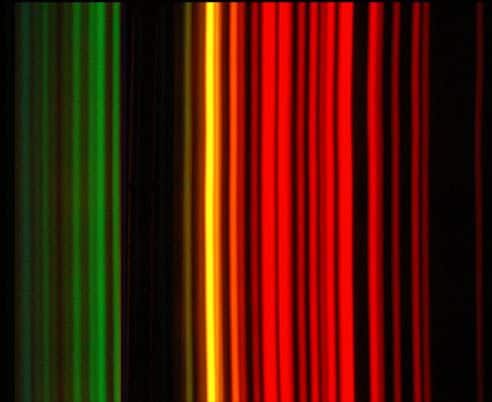Neon is a chemical element that glows when electricity is passed through it. Neon signs and lights are fixtures of city landscapes, glowing in different vibrant colors. But what causes neon to glow in these different hues? The answer lies in the unique structure and properties of the neon atom. By understanding the neon atom, we can uncover what leads to its chameleon-like ability to shift color.
Properties of the Neon Atom
Neon, represented by the symbol Ne on the periodic table, is a noble gas. Noble gases like neon have very stable and inert electron configurations, meaning their atoms do not readily participate in chemical reactions.
Neon has 10 electrons, 2 in the inner shell and 8 in the outer shell. These electrons orbit the nucleus in specific energy levels or electron shells. The outermost electrons, called valence electrons, have the highest energy and determine the chemical properties of the atom.
When electricity excites a neon atom, the valence electrons jump up to higher energy levels further from the nucleus. But neon wants to return to its stable, unexcited state. As the electrons drop back down, they emit energy as visible light photons.
The color of the emitted light depends on the energy level difference between the excited and ground states. Smaller energy gaps emit lower energy red/orange photons, while larger gaps release higher energy blue/violet photons.
Emission Spectra
The distinct lines of colored light emitted by an atom are its emission spectrum. Neon’s emission spectrum reveals the precise energy jumps its electrons make.
| Color | Wavelength (nm) | Energy Transition |
|---|---|---|
| Red | 646 | 2p → 1s |
| Orange | 616 | 3p → 1s |
| Yellow | 588 | 3p → 2s |
| Green | 541 | 3s → 2p |
| Blue | 436 | 4p → 1s |
| Violet | 412 | 5p → 1s |
The transitions show electrons falling from higher energy 3p, 4p, 5p orbitals down to lower 1s and 2s levels. Shorter wavelength violet photons have more energy than longer wavelength red photons.
When only certain transitions are induced, neon emits single colors. But mixing different combinations creates multi-colored neon lights.
Gas Discharge Tubes
Neon lights utilize long sealed glass tubes with a neon and argon gas mixture. The tubes have metal electrodes at both ends.
When a high voltage is applied, the electric current ionizes the gases, stripping electrons and creating positively charged ions and free electrons. Electrons accelerate rapidly between electrodes, colliding with and exciting neon atoms.
Excited neon atoms give off photons as their electrons return to ground state. The glass tube confines the light, causing the neon gas to glow.
Changing the voltage controls the excited energy levels and thus the photon colors emitted. Higher voltages promote electrons to higher energy transitions, generating more high-frequency violet and blue light.
Penning Mixing
Another way to manipulate neon’s emission spectrum is by mixing other gases, especially argon. This is called Penning mixing.
Argon has a higher ionization potential, meaning its atoms require more energy to ionize into positive ions and free electrons.
When an electron collides with an argon atom, the argon may get excited but not ionized. The excited argon can then transfer energy to a neon atom without ionizing it.
This promotes neon electrons into higher energy levels not normally accessible. Penning mixing with argon causes more violet and blue light emission.
Plasma Displays
Neon lighting principles are applied in color plasma displays. These use neon and xenon gas mixtures confined between glass plates.
Electrodes excite the separate RGB (red, green, blue) plasma cells to emit colored light. By controlling the voltage, the neon-xenon plasma can produce a full spectrum of colors.
| Gas | Color |
|---|---|
| Neon | Red |
| Xenon | Blue |
| Neon-Xenon Mix | Green |
Chemical Reactions
Although neon is normally inert, it can form compounds under extreme conditions. Interestingly, when reacting with fluorine, neon changes color.
The compound neon fluoride (NeF) has 6 outer electrons. This half-filled shell absorbs longer wavelength red and orange light. NeF appears blue as the complementary color transmits.
Other reactive neon compounds with oxygen and hydrogen also absorb red/orange light, fluorescing blue. This demonstrates chemical bonding can also induce color shifts.
Liquefied and Solid Neon
Cooling neon gas condenses it into a liquid around -246°C. Liquid neon has an unexpected brilliant red-orange color absent in the gas.
The liquid state brings neon atoms closer together, allowing additional energy exchanges between atoms. This causes more long-wavelength red and infrared emissions.
Further cooling solidifies neon into a reddish-orange crystalline solid around -249°C. Solid neon’s color results from similar interatomic energy transfer effects in the condensed closely packed crystal lattice.
Isotopes
Neon has three stable isotopes in nature, 20Ne, 21Ne, and 22Ne, denoting different atomic masses.
Isotopes have identical electron configurations but slightly different energy levels and emission spectra. This can subtly alter emitted photon colors, causing isotope shifts.
For example, 21Ne and 22Ne glow more reddish-orange compared to pure 20Ne. However, these isotope differences require extremely high-resolution spectroscopy to discern. So most neon light consists of a mixture of indistinguishable isotopic colors.
Conclusion
What gives neon its chameleon-like array of vibrant colors? In summary:
– Excited electron energy level transitions in the neon atom
– Gas discharge tubes with alternating current
– Penning mixing with argon gas
– Chemical bonding and reactions
– Phase changes to liquid and solid states
– Isotopic shifts between 20Ne, 21Ne and 22Ne
By leveraging these effects, neon reveals its hidden spectrum. Harnessing the unique physics and chemistry of the neon atom unlocks a rainbow of colorful illumination.


